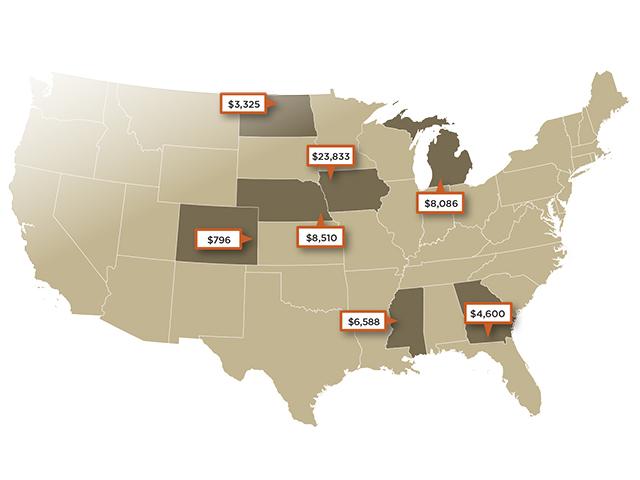Winter Wheat Tour Day 1 Yields 50.5 BPA
Scouts Encounter Moisture Deficits and Disease on Hard Winter Wheat Tour Day 1
This article was originally posted at 8:15 p.m. CDT on Tuesday, May 13. It was last updated with additional information at 11:38 p.m. CDT on Tuesday, May 13.
**
COLBY, Kan. (DTN) -- Like many farmers in north-central and northwest Kansas this past fall, Chris Tanner of Norton, Kansas, was optimistic about his hard red winter wheat crop going into winter dormancy.
"In 30 years of farming, it was the best crop I'd seen in the fall," he told DTN during Day 1 of the Wheat Quality Council's 2025 Hard Winter Wheat Tour. "But then the winter was dry. The spring was abnormally warm, and the crop came out of dormancy earlier and started using up moisture right away.
"We've been kind of surviving on timely rains for the past several years, but they've been patchy this year. We've had a quarter-inch here, three-tenths there, but not your typical soaking rain," Tanner said. "Given that there's not really any chance of rain in the near future, I would anticipate that 50% of my wheat acres will not be harvested."
Many of those abandoned wheat acres will be on continuously cropped ground. Tanner expects that his summer fallow wheat, which typically yields from 80 to 100 bushels per acre (bpa), has a chance to produce 40 to 50 bpa -- if the crop can catch a rain by the end of the week.
Stories like Tanner's provided much of the narrative for the conversation that occurred at the conclusion of Day 1 of the Hard Winter Wheat Tour, which arrived in Colby after scouting wheat fields across the northern half of Kansas and five counties in Nebraska.
P[L1] D[0x0] M[300x250] OOP[F] ADUNIT[] T[]
WEIGHTED AVERAGE YIELD 50.5 BPA
In total, the group assessed 196 wheat fields along six routes, estimating a weighted average yield of 50.5 bpa. It was the second-highest Day 1 yield average in the past decade for the tour, bested only by 2021 when the route averaged 59.2 bpa.
Estimated yields ranged from a low of 10 bpa to a high of 97 bpa. Drought stress was noted in most fields.
"In far northwest Kansas, really getting north of I-70, we've missed out on most of these rains that the rest of the state has enjoyed," said Lucas Haag, an agronomist with Kansas State University. "If you came across Highway 36 today or down Highway 383, there's some really tough-looking wheat that really went backwards in the past five to seven days. Even our summer fallow wheat, which is typically our higher yield potential wheat, is now going backwards pretty quickly."
DISEASES NOTED
Also noted was the presence of wheat streak mosaic virus, which began to show up in earnest in northwest Kansas around Easter as temperatures began to warm up, said Jeanne Falk Jones, a multi-county agronomy specialist with Kansas State University Extension based in Colby.
On Monday, K-State Extension Wheat Pathologist Kelsey Andersen Onofre shared with tour participants that this disease complex can be caused by several viruses, including wheat streak mosaic virus, Triticum mosaic virus and high plains wheat mosaic virus.
These viruses are vectored by the wheat curl mite, a near-microscopic mite that survives between seasons on volunteer wheat and other grassy hosts. These grassy hosts serve as a "green bridge" for mites to survive from one wheat crop to the next. Infections may occur in the fall or spring, but fall infections typically result in the highest levels of yield loss. Although wheat streak mosaic infections can happen at any time, symptoms develop most rapidly at temperatures above 70 degrees Fahrenheit.
"In 2024, Kansas experienced a very warm fall with higher-than-normal temperatures from September through November," Andersen Onofre said. "These conditions may have sustained periods of time that were highly favorable for mite reproduction and movement across fields."
Despite the effects of drought conditions and disease, the USDA National Agricultural Statistics Service (NASS) Crop Progress and Condition Report released May 12 still estimated that 42% of the Kansas winter wheat crop was in good condition, up 2% from the previous week. NASS rated the remainder of the crop as 7% very poor, 15% poor, 30% fair and 6% excellent.
On Wednesday, May 14, Day 2 of the hard winter wheat tour moves into southwest and south-central Kansas, with one route extending into select counties in Oklahoma. The tour day ends in Wichita.
**
Editor's Note:
DTN Crops Editor Jason Jenkins is participating on this year's tour. Look for more daily updates and final yield estimates on www.dtnpf.com and on social platform X.
Jason Jenkins can be reached at jason.jenkins@dtn.com
Follow him on social platform X @JasonJenkinsDTN
(c) Copyright 2025 DTN, LLC. All rights reserved.






